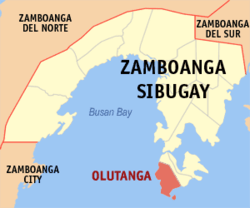Olutanga, Zamboanga Sibugay
| Olutanga | |
|---|---|
| Municipality | |
| Municipality of Olutanga | |
 Map of Zamboanga Sibugay with Olutanga highlighted | |
.svg.png) Olutanga Location within the Philippines | |
| Coordinates: 7°20′N 122°50′E / 7.33°N 122.83°ECoordinates: 7°20′N 122°50′E / 7.33°N 122.83°E | |
| Country |
|
| Region | Zamboanga Peninsula (Region IX) |
| Province | Zamboanga Sibugay |
| District | 1st District |
| Barangays | 19 (see Barangays) |
| Government [1] | |
| • Type | Sangguniang Bayan |
| • Mayor | Arthur Ruste Sr. |
| • Vice Mayor | Joel Autida |
| • Electorate | 13,489 voters (2016) |
| Area [2] | |
| • Total | 113.30 km2 (43.75 sq mi) |
| Population (2015 census)[3] | |
| • Total | 33,671 |
| • Density | 300/km2 (770/sq mi) |
| Time zone | UTC+8 (PST) |
| ZIP code | 7041 |
| PSGC | 098310000 |
| IDD : area code | +63 (0)62 |
| Climate type | Tropical climate |
| Income class | 4th municipal income class |
| Revenue (₱) | 83,045,850.82 (2016) |
| Native languages |
Subanon language Cebuano Chavacano Tagalog |
| Website |
www |
Olutanga, officially the Municipality of Olutanga, is a 4th class municipality in the province of Zamboanga Sibugay, Philippines. According to the 2015 census, it has a population of 33,671 people.[3]
The municipality is in the southwestern part of the eponymous Olutanga Island.
Barangays
Olutanga is subdivided into 19 barangays.
- Bateria
- Calais
- Esperanza
- Fama
- Galas
- Gandaan
- Kahayagan
- Looc Sapi
- Matim
- Noque
- Pulo Laum
- Pulo Mabao
- San Isidro
- San Jose
- Santa Maria
- Solar (Poblacion)
- Tambanan
- Villacorte
- Villagonzalo
Demographics
| Population census of Olutanga | ||
|---|---|---|
| Year | Pop. | ±% p.a. |
| 1960 | 16,926 | — |
| 1970 | 16,991 | +0.04% |
| 1975 | 15,623 | −1.67% |
| 1980 | 14,539 | −1.43% |
| 1990 | 16,378 | +1.20% |
| 1995 | 17,069 | +0.78% |
| 2000 | 22,624 | +6.23% |
| 2007 | 27,521 | +2.74% |
| 2010 | 28,717 | +1.56% |
| 2015 | 33,671 | +3.08% |
| Source: Philippine Statistics Authority[3][4][5][6] | ||
Educational institutions
Tertiary
- Western Mindanao State University - External Studies Unit (WMSU)
High schools
- Loyola High School
- Olutanga National High School
- Pantaleon Cudiera National High School (Formerly Bateria NHS)
Elementary
- Olutanga Central Elementary School
- Bateria Elementary School
- Buhangin Mahaba Elementary School
- Esperanza Elementary School
- Fama Elementary School
- Gandaan Elementary School
- Kahayagan Elementary School
- Kalines Elementary School (Formerly Calais ES)
- Kauswagan Elementary School
- Matim Elementary School
- Pulo Laum Elementary school
- San Jose Elementary School
- Sta. Maria Elementary School
- Tambanan Elementary School
- Villa Gonzalo Elementary School
- Villacorte Elementary School
Primary
- San Isidro Primary School
References
- ↑ "Municipality". Quezon City, Philippines: Department of the Interior and Local Government. Retrieved 31 May 2013.
- ↑ "Province: Zamboanga Sibugay". PSGC Interactive. Quezon City, Philippines: Philippine Statistics Authority. Retrieved 12 November 2016.
- 1 2 3 Census of Population (2015). "Region IX (Zamboanga Peninsula)". Total Population by Province, City, Municipality and Barangay. PSA. Retrieved 20 June 2016.
- ↑ Census of Population and Housing (2010). "Region IX (Zamboanga Peninsula)". Total Population by Province, City, Municipality and Barangay. NSO. Retrieved 29 June 2016.
- ↑ Censuses of Population (1903–2007). "Region IX (Zamboanga Peninsula)". Table 1. Population Enumerated in Various Censuses by Province/Highly Urbanized City: 1903 to 2007. NSO.
- ↑ "Province of Zamboanga Sibugay". Municipality Population Data. Local Water Utilities Administration Research Division. Retrieved 17 December 2016.
External links
This article is issued from
Wikipedia.
The text is licensed under Creative Commons - Attribution - Sharealike.
Additional terms may apply for the media files.